“Rockwell Models”
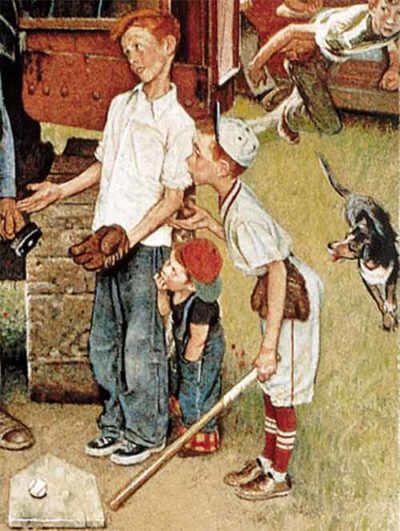
Rockwell Models in “Progress?”
From August 21, 1954
One advantage of living near Rockwell in the 1950s is that you had a good chance of being forever remembered in a Saturday Evening Post cover.
“Progress?” – August 21, 1954
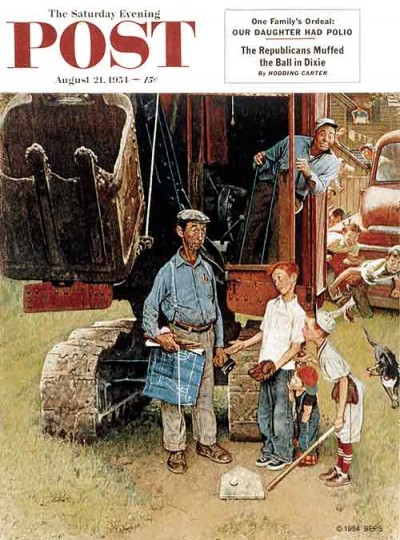
“Progress?”
From August 21, 1954
This is progress? The construction crew is meant to build a cellar, but along come the local would-be All Stars pleading, “Gee, mister, this is our baseball lot!”
Rockwell gathered up models for this scene in midwinter by knocking on doors (in Stockbridge, Mass.) and rousting up members of the Little League team. My favorite touch is tiny Scott Ingram sucking his fingers as the negotiations proceed. The boy in the baseball suit is big brother, Kenneth Ingram. We’ll see Scott again.
The workers appear sympathetic, but we suspect things do not bode well for the great American pastime.
According to Kenneth, Scott’s best buddy was Eddie Locke (below).
“Before the Shot”– March 15, 1958
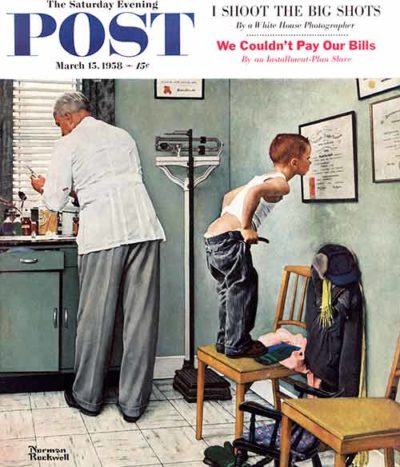
“Before the Shot”
From March 15, 1958
We recently showed you Eddie Locke as “The Runaway” (see: ROCKWELL: BEHIND THE CANVAS). The young man shows up on yet another classic Rockwell cover: as the boy checking out the doctor’s credentials before getting a shot.
The physician preparing the shot was Donald Campbell, a real local doctor. “Norman lived across the street from me for a number of years, said Dr. Campbell in a 1976 issue of the Post. “It was a familiar sight to see his long legs carrying him down to the studio regularly before eight a.m. “
Dr. Campbell continued, “Norman couldn’t help being nice to people, especially children. When my five-year-old Betsy fell from her bike because a little dog followed her, barking, Norman gathered her up, stopped her tears and took her home with him. With Betsy on his knee, he drew a series of pictures as in a cartoon, showing a little dog chasing a little child on a bike. The picture showed the little girl’s face with the caption, ‘See. The nice little dog only wanted to play.’”
“Girl at the Mirror” – March 6, 1954
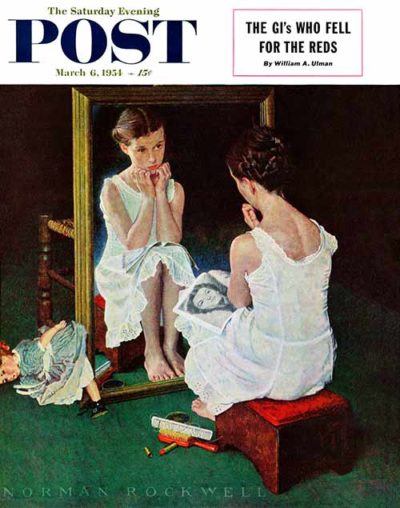
“Girl at the Mirror”
From March 6, 1954
Rockwell once called Mary Whalen his favorite model, even if the young girl on the cover didn’t think she measured up to Jane Russell (who did?). The artist captures the “in-between” age well between the cast away doll and the closer “necessities” of lipstick and hairbrush.
Mary’s first memory of the artist “was at a high school basketball game in Arlington, Vermont, about 1950. His son Tommy was on the local team, so along with nearly everybody else in town, Norman was there to cheer them on. When I harassed my Dad for a Coke, a friendly man sitting behind us gallantly reached over my shoulder and invited me to drink some of his Coke. That was the beginning of my admiration for Norman Rockwell.”
How did Rockwell get the facial expressions he wanted from the kids? “He would laugh and shout, pound the floor, or jump up and down,” Mary recalled. “He did the acting while I reacted. What a wonderful moment of joy when Norman drew forth from me the expressions he wanted. He would burst out laughing, with happy shouts. It is the memory of those triumphant, creative moments which I treasure most,” she recalled, more than twenty years later. “I can still hear deep within me his laugh of celebration.”
“A Day in the Life of a Girl” – August 30, 1952
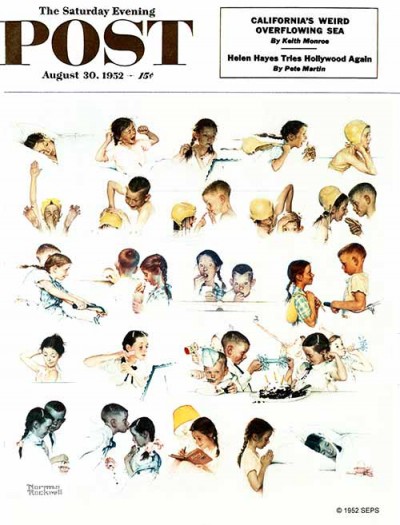
“A Day in the Life of a Girl”
From August 30, 1952
Earlier in 1952, Rockwell did a cover called “A Day in the Life of a Boy,” which follows a boy getting up and ready for school, playing baseball, getting distracted by a pretty girl, and so on. A few months later, the summer version, “A Day in the life of a Girl” appeared. Both covers featured Charles Marsh, Jr. and Mary Whalen. Mary awakens, then it’s off to go swimming, where a young man promptly tries to drown her. The spirited lass returns the gesture, and it was love at first fight.
The last row shows a chaste kiss, which Marsh just couldn’t pull off. “I considered her my girlfriend then,” he said later, but I had never built up enough courage to kiss her. Mr. Rockwell finally gave up on trying to get me to kiss her and posed us puckering separately.” The ordeals of being a model!
“The Missing Tooth”- September 7, 1957
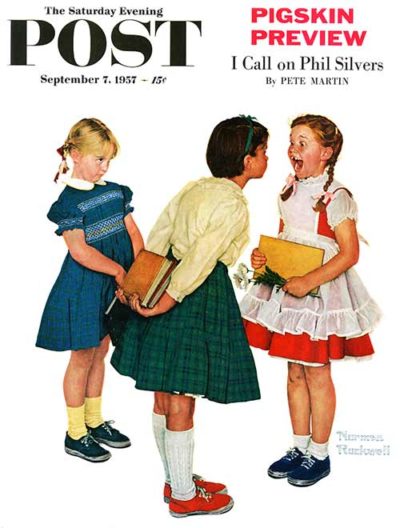
“The Missing Tooth”
From September 7, 1957
When Rockwell needed a child for a Crest ad (“Look, Ma! No Cavities!”), he asked his friends, the Morgans, if he could borrow their daughter. When cute little Ann Morgan showed up at the studio, she was missing two front teeth. Oops. “Mr. Rockwell went ahead and painted my front teeth in for the ad,” said grown-up Ann Morgan Baker in 1976, “but my missing teeth may have given him the idea for a Post cover.”
Living near a famous artist had its perks: “Being on the cover changed my life,” Ann said, “People were always saying, ‘I saw you in Chicago,’ or ‘I saw you in a drugstore window in New York.’ I thought of myself as a tiny little international star.” And the modeling fee? “$25 when you’re six is a lot of money.” Famous AND rich—what more could you ask for?
Having Rockwell as a family friend has its odd moments, too. The artist would call Ann’s mother “at 7 a.m. and say, ‘Don’t make the beds. I want to come and look at some messy rooms.’ Then he would come and wander through our morning rubble.”
Ann’s first love? Neighbor and fellow Rockwell model, Scott Ingram (above as the littlest ball player and below).
“The Discovery” – December 29, 1956
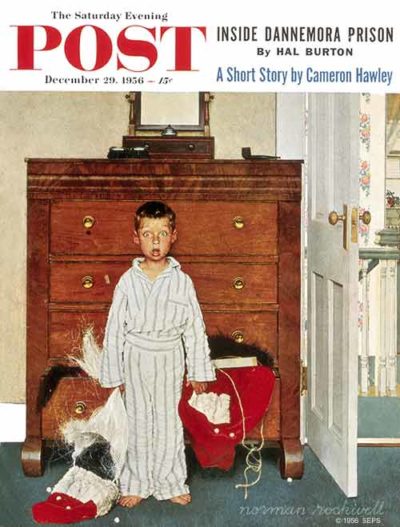
“The Discovery”
From December 29, 1956
Poor little Scott Ingram—this unexpected discovery is suddenly answering a lot of questions. The good news is that this 1956 cover also made him a celebrity of sorts. He actually got fan mail and even made a television appearance with the famous artist. He enjoyed working with Rockwell, and looked forward to the end of each session, when he would be treated to a milkshake.
The painting is more multi-faceted than the first glance would indicate. The way Rockwell captured the burling of the wood of the dresser is one such detail. And life for the artist would have been easier had he just closed the door. Instead, he replicated the patterned wallpaper outside the room, illuminated by the light of a window we have the barest glimpse of.
Next: Rockwell in the 1950s Part II —including a controversial topless model.
Become a Saturday Evening Post member and enjoy unlimited access. Subscribe now
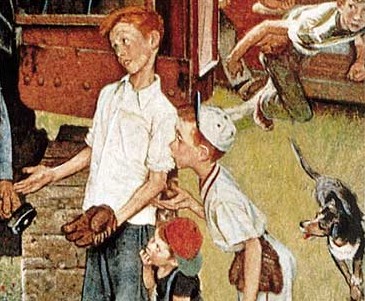

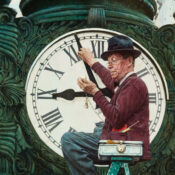
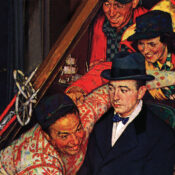
Comments
I love reading the details about Rockwell’s paintings and details about his models.
I remember those days with such fond memories! Kids actually played together instead of texting and sitting on computers. We used to stay outdoors until dark playing tag, jump rope, baseball, touch football, exploring woods and taking a lunch with us, and any other activity that required that we be outdoors.
Indoors we would read the classics and look forward to an hour of tv as a treat.
I love all the Norman Rockwell paintings! I hadn’t seen the ones above.
Of course, I enjoy my Saturday Evening Post. I’m almost finished reading
the present issue.
Evelyn Long
I wonder if anyone knows if Norman Rockwell worked as a mentor/teacher to
a John Waters, an artist from Georgia and New York sometime in the ’40’s or ’50’s. I know of some paintings of Mr. Waters that have never been exposed to public view. I think they are good works.
I was privileed to visit the Rockwell studio when on a tour of New England states in their Autumn finery. I have a copy of a Rockwell book on my coffee table. How can he not be an American, no, International favorite?
I introduced my preschool children to Norman Rockwell back in the early 70’s. We would sometimes look at his drawings rather than read a familiar bedtime story. All three of them appreciated his art. Now I am emailing this page to my 11 year old granddaughter:) so she can enjoy Mr. Rockwells paintings too.